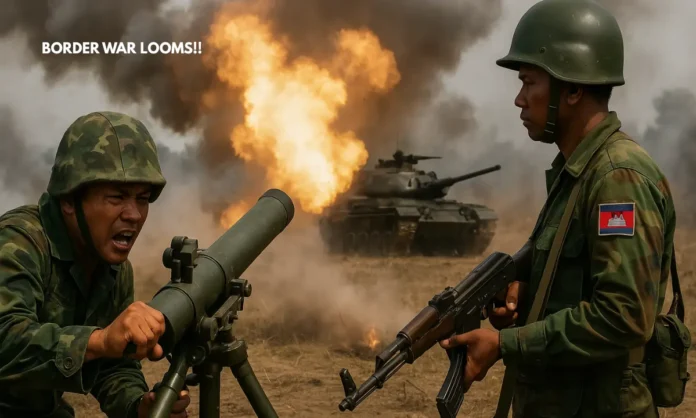Summary
- Thai military imposes martial law in 8 border districts after deadly clashes.
- At least 15 killed in Thailand and thousands evacuated amid heavy shelling.
- UN Security Council to hold emergency meeting as ASEAN seeks mediation.
Border Conflict Intensifies Amid Civilian Casualties
Thailand’s acting Prime Minister Phumtham Wechayachai warned that the ongoing clashes with Cambodia “could develop into war” as fighting with artillery, jets, and tanks intensified for a second consecutive day. The conflict, which has left at least 15 dead and 46 injured in Thailand, erupted over a long-standing border dispute that flared up again in May after a Cambodian soldier was killed.
The clashes have displaced over 138,000 people from Thailand’s border areas, with reports of rockets striking civilian infrastructure, including hospitals and fuel stations. Cambodian authorities confirmed civilian casualties, with one 70-year-old man killed and several wounded in Oddar Meanchey province. Both nations accuse each other of initiating the latest hostilities.
Martial law officially declared in parts of Thailand over hot military conflict with Cambodia.
— Major Anthony Jones (@majorbrainpain) July 26, 2025
* Thailand and Cambodia are on the brink of war after Cambodia launched rocket attacks on Thai villages, killing 12 civilians and evacuating 40K. Thailand responded with F‑16… pic.twitter.com/JUa4BK3pqU
Thailand’s Military Measures and Diplomatic Signals
- Martial law declared in 7 districts of Chanthaburi and 1 in Trat.
- F-16 jets deployed by Thailand in response to Cambodian rocket attacks.
- Foreign ministry signals openness to talks via Malaysia or ASEAN channels.
Thailand’s military responded with “appropriate supporting fire” against Cambodian positions while bolstering border defenses. Acting PM Wechayachai emphasized that while Thailand prefers diplomatic resolution, the military is “ready for immediate action” if provoked further.
Foreign ministry spokesman Nikorndej Balankura said Thailand is willing to hold talks, potentially facilitated by Malaysia, which currently chairs ASEAN. However, Cambodian Prime Minister Hun Manet accused Thailand of backtracking on truce efforts, indicating a stalemate in negotiations.
Historical Dispute and International Reactions
- 800-kilometre border dispute has led to repeated clashes since 2008.
- Ancient temple sites remain flashpoints for both militaries.
- China and ASEAN urge restraint; UN Security Council to convene.
The current conflict is rooted in historical disputes over border demarcations dating back to French colonial maps and the Franco-Siamese treaties. Fighting between 2008 and 2011 left over 28 dead and tens of thousands displaced, but a 2013 UN ruling temporarily eased tensions.
Chinese Foreign Minister Wang Yi called the rising casualties “deeply distressing,” urging both nations to approach the situation “calmly and responsibly.” The UN Security Council will hold an emergency session to address the escalating violence and its impact on regional stability.
Regional Fallout and Next Steps
The clashes have rattled Southeast Asia’s economic and tourism hubs. Thailand’s baht and stock markets dipped amid fears of prolonged conflict, while Cambodia faces infrastructure and civilian safety crises along its border. Analysts warn that without immediate mediation, the situation could spiral, impacting trade, tourism, and cross-border movement.
A Precarious Crossroads for Thailand and Cambodia
The imposition of martial law along Thailand’s border with Cambodia signals how rapidly this decades-old territorial dispute has escalated into a grave security crisis. With over 130,000 people displaced, civilian casualties mounting, and heavy weaponry deployed, both nations stand on the brink of a full-scale conflict. The use of artillery, jets, and rockets underscores a dangerous shift from skirmishes to structured military engagements.
Diplomatic intervention is now critical. ASEAN, led by Malaysia’s current chairmanship, has a narrow window to mediate before the situation spirals further. The UN Security Council’s emergency meeting could be a decisive moment, but both Thailand and Cambodia must demonstrate a willingness to pause hostilities and engage in dialogue.
Economically and geopolitically, prolonged fighting would weaken both nations, disrupting tourism, trade, and investor confidence, while potentially inviting external influence from regional powers like China.
The final verdict: this crisis is a test of ASEAN’s capacity to enforce regional stability. Without a swift ceasefire and a credible negotiation framework, the conflict risks undoing a decade of relative peace and could ignite a broader humanitarian and economic fallout across Southeast Asia.


